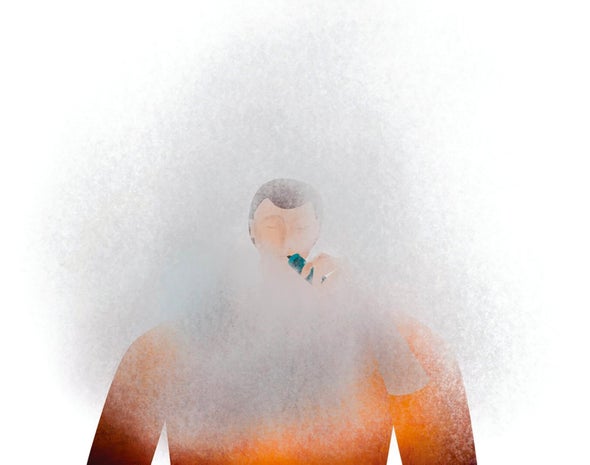The first sign that something was wrong was trouble breathing. “I thought my lungs were giving out on me,” Marcus recalls. “When I breathed in, my lungs hurt.” About a week later he began vomiting violently, unable to hold down food. It was the beginning of an ordeal last October that landed the otherwise healthy 18-year-old (who prefers to keep his last name private) in an intensive care unit. Doctors at Utah Valley Hospital in Provo found that the teenager's blood oxygen level had plummeted into the 80s (normal levels are 95 and above). A CT scan showed a hazy “ground-glass” pattern of white flecks in his lungs—an indication of severe damage often seen in patients with COVID-19. With the pandemic raging, doctors tested Marcus three times for the coronavirus. All results were negative. Marcus himself suspected another culprit: something noxious he had inhaled from a vape pen.
His hunch proved right. Marcus was diagnosed with a life-threatening condition recognized only since 2019: e-cigarette or vaping product use–associated lung injury, or EVALI. The first known cases appeared in Wisconsin in June 2019. Before long the Centers for Disease Control and Prevention was receiving reports of this mysterious illness from all 50 states. By mid-February 2020, 2,800 people had been hospitalized with it, and 68 had died. Two thirds of the afflicted were male, and most were young adults.
Fortunately, science moved almost as fast as the outbreak. By early October 2019 the Food and Drug Administration had linked the cases to vaping products containing tetrahydrocannabinol (THC), the main psychoactive component of marijuana, and issued a public warning to avoid such products. FDA investigators began sampling THC vape liquids and discovered that half contained vitamin E acetate, a substance used commercially to thicken skin creams. Its effects when inhaled had not been examined. At the CDC, a research team studied lung fluid samples from 51 patients and found vitamin E acetate in 48 of them. “That helped us connect all the dots from what was in the product and what was in the body of the individuals,” says epidemiologist Brian King, who helped lead the agency's emergency response team and co-authored a report on the findings in the New England Journal of Medicine.
Questions remained as to whether other vaped compounds were also playing a role, but mouse studies settled the issue. “A couple of research groups had mice inhale pure vitamin E acetate for a few days, and it induced crazy amounts of lung damage, so it was very clear,” says pulmonologist Laura Crotty Alexander, who studies EVALI at the University of California, San Diego.
In a period when public health authorities have been struggling to contain a global crisis, it is good to be reminded of how well their efforts can work. EVALI cases such as Marcus's continue to be reported, but the numbers have fallen dramatically since the cause was identified. “We had a peak in September 2019, and it's been declining since then,” King says. He and other experts believe that public warnings raised awareness and may have prompted producers of THC vape liquids to stop cutting their wares with the vitamin, which was used to add volume and make a cheaper product.
EVALI is one of at least three diseases caused by vaping and e-cigarettes. Scarring of the lung's tiny air sacs known popularly as popcorn lung has been traced to vape liquids containing diacetyl, a flavoring that used to be added to popcorn. Nicotine vapes are associated with a type of pneumonia. “So many people think vaping in general is safe, but there are thousands of chemicals being added for flavor, for mouthfeel, for the look of the [exhaled] cloud,” Crotty Alexander says, and the risks of many additives are unknown.
About 20 percent of U.S. high school students say they use some kind of e-cigarette or vaping device, down from 27.5 percent in 2019. The drop most likely reflects federal regulatory actions, including raising the minimum age for buying tobacco products from 18 to 21 and outlawing the fruity and candy-flavored cartridges that attract young users. But THC vapes are tougher to regulate, Crotty Alexander says, because most are made by small, informal producers—legally or illegally, depending on the state.
She and others are investigating the long-term outcomes of EVALI. Most patients respond well to steroids and oxygen support, if needed, and seem to make a good recovery. Marcus is one of them. “We are very lucky that EVALI was already recognized when COVID hit,” Crotty Alexander says. Otherwise the signal of this risky lung disorder might have been lost in the noise of the pandemic.


